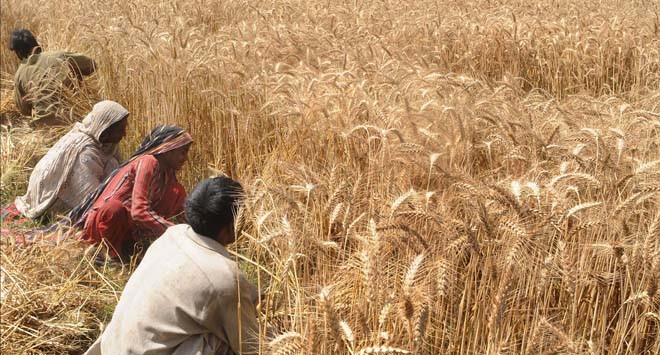

Climate extremes are affecting major agricultural regions and creating regional food crises. Continuously rising earth’s temperature is expected to rise by 5-7 C by the end of 21st century. Pakistan in general and Indus Delta in particular would experience a 4 to 6 C rise in temperature by that time on an average 0.5 C rise per decade. It would have horrifying impacts on our food system if we do not go for solutions being proposed by scientists and agricultural experts.
Wheat and rice are the main crops in Pakistan not only in respect of their consumption but also in view of large exports (rice). These are grown on approximately 8.69 and 2.31 million hectares with a total production of 24.2 and 5.54 million tons, respectively. These crops are cultivated in different agro-ecological zones of Pakistan, with each zone representing diverse socio-economic, hydrological and climatic conditions.
Wheat is the main staple grain food of Pakistan. It has a share of 2.2 per cent in GDP and 10.1 per cent in value addition and has three major groups i.e. bold grain size, medium grain size and small grain size. Similarly, rice is the second staple grain food of Pakistan. Its share in GDP is 0.6 per cent and 2.7 per cent in value addition with two major groups i.e. Basmati 48 per cent and Irri (coarse rice) which is 52 per cent of total rice production.
Agro-Climatologist Dr Fahd Rasul says that due to changing climate and extreme climate events, there is a threat of significant decrease in rice-wheat cropping system of Punjab. He says that these assessments should be provided to decision-makers with information for developing appropriate plans to reduce threats by climate changes for food security and prosperous future.
Agronomy Department, University of Agriculture Faisalabad, is working to measure the impacts of climate change on Pakistan’s food crop and the solutions to cope with the situation with the cooperation of AgMIP (Agriculture Models Inter-Comparison and Improvement Project) which is an international consortium for improvement of crop, climate and economic models. Its main objective is to study climate change and to improve substantially food security and enhance adaptation capacity. It works on inter-comparisons of various technologies to improve crop and economic models.
Keeping in view the changing weather patterns, scientists have proposed different solutions to increase production and to counter the climate change. Farmers can have good results by selecting improved cultivars (short lag phase, deep root system) and better management (high input use efficiency, manipulation of sowing time and planting density). For rice transplantation, 25-day old nursery has been suggested. Wheat-sowing should be 15 days earlier than the present sowing date. About 15 per cent and 25 per cent increase in planting density of rice and wheat, respectively and use of 15 per cent more fertilizer in rice and 20 per cent in wheat will give amazing results, scientists claim.
Dr Ishfaq Aham, an economist working on the economical impacts of adaptation of crop models, is hopeful that with the adaptation of these strategies the number of gainers would rise above 80 per cent which is threatened to be 25 per cent otherwise and overall poverty rates of population will reduce to almost 17 per cent. "Per capita income for adopters could be around Rs200,000."
Dr Ashfaq Ahmad Chattha, related to AgMIP Pakistan, says that there is a dire need to establish and strengthen interaction among stakeholders. "There should be agro-climatic advisory services for farmers dealing with early warning system and continuous crop monitoring and forecasting using climate, crop and economic models."
Pakistan Meteorological Department has set up a National Agro-Met Center (NAMC) which aims to address the needs of the farming community and other related stakeholders through provision of weather advisory information and services by using various delivery channels available in their vicinity.
Dr Khalid Malik, Director Pakistan Meteorological Department, says "The purpose of establishment of National Agro-Met Center is to support and provide meteorological, climatological information and advisories about agricultural production and food security in the country."
Besides climate change and variability, rice-wheat system is facing some other issues as well i.e. lack of improved production technology, water problem, soil conditions, exhaustive crops, terminal heat stress in wheat, insects/pests and diseases. These all issues are also needed to be addressed and experts suggest that these can be addressed by using improved and site-specific production technology, sequestration of green house gases, surface seeding practice and bed planting of wheat, integrated pest and nutrient management, laser land-levelling (precision agriculture), cultivation of aerobic rice and intensification of rice-wheat system.
The data and proposed guidelines by the scientists project an encouraging situation. Proper coordination among stakeholders and information to farmers and their willingness to adopt these guidelines is necessary for better results.
Recent research says that there would be increase of 2.8°C in maximum and 2.2°C in minimum temperature in Punjab for mid-century (2040-2069). Vulnerability of the agriculture crops to extreme climate events (floods, droughts, cyclones etc) will increase with time due to increased climatic changes and global warming. Scientists agree that assessments and adaptation planning are needed for better food security in the country.